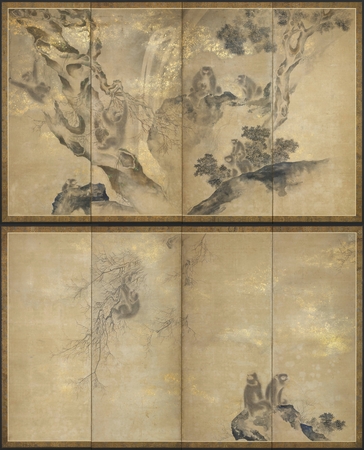Product Description
7336/37 A pair of four-fold paper screens painted in ink and colour on a buff ground depicting a troupe of saru (monkeys) in a winter landscape with mist rendered in sunago (sprinkled gold). The right hand screen shows several monkeys and their young, two are climbing a large gnarled tree while the rest inhabit a rocky landscape beside a waterfall. The left hand screen has two monkeys seated on a rock, one with its head turned to watch a third climbing the branch of a tree above them
Mori school, Japan 18th/19th century period Edo period
Dimensions: H. 68″ x W. 109½” (172.5cm x 278cm) each
Macaques once inhabited much of Japan and their interaction with humans was frequent. Saru (monkey) thus became a natural focus of local folklore and religion. As illustrated by one of the many sacred Shinto myths the Japanese held saru in high regard. The ancient myth in the texts of Kojiki (Record of Ancient Matters, 711AD), tells of when the sun goddess Amaterasu sent her grandson Ninigi no Mikoto down from the heavens to rule Japan, the grandson was met midway by an escort deity named Sarutahiko no Mikoto (prince monkey). This deity is generally considered to be connected to the monkey and as an escort deity it is known as a guardian of roads, travellers and guidance.
With the transition from the medieval period to the early feudal era in Japan, the monkey’s religious significance declined while its reputation for being clever and mischievous grew.









